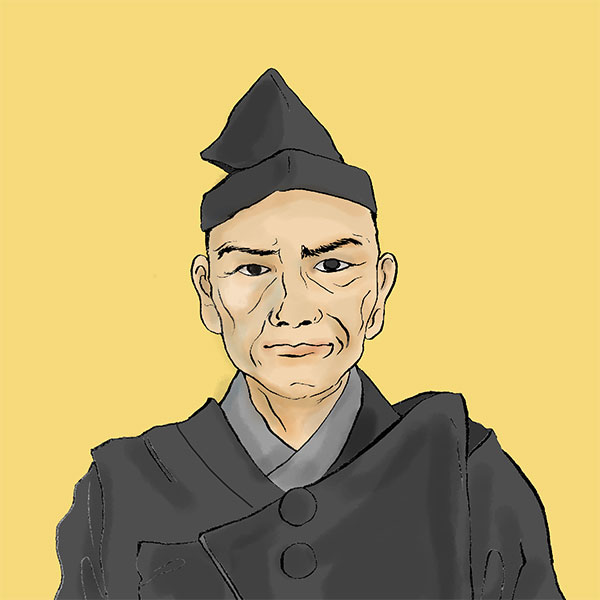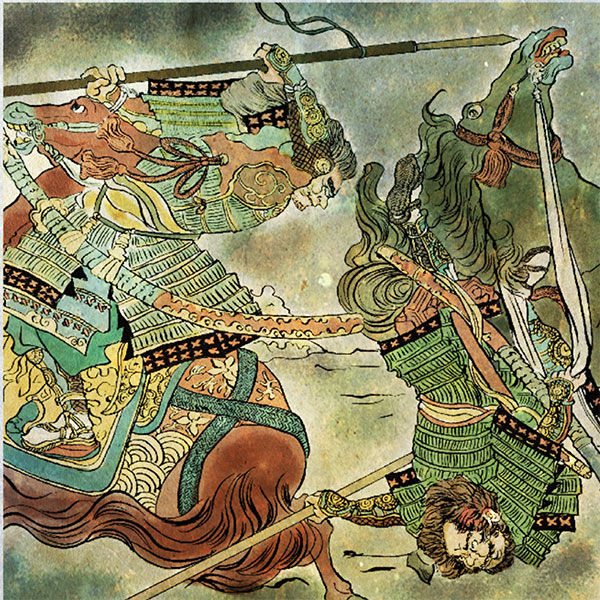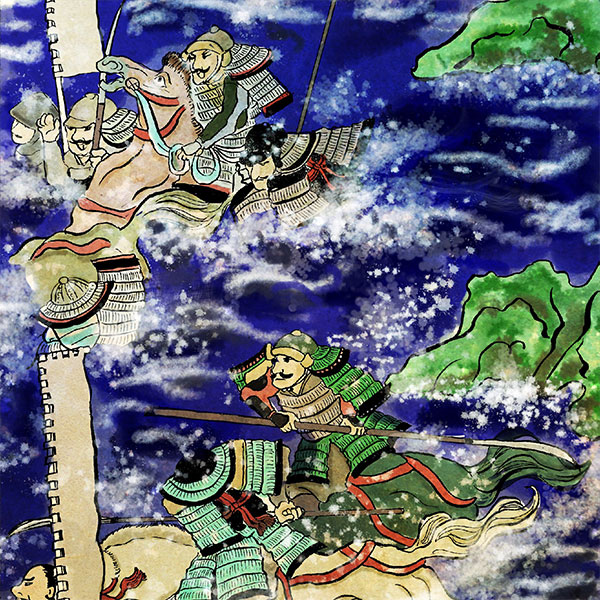Yoshihisa Shimazu (2/2)Commander-in-chief of the three states

Yoshihisa Shimazu
- Article category
- biography
- name
- Yoshihisa Shimazu (1533-1611)
- place of birth
- Kagoshima prefecture
- Related castles, temples and shrines

Kagoshima Castle

Kokubu Castle
- related incident
Toyotomi Hideyoshi secured Satsuma, Osumi Province, and parts of Hyuga Province as territories for the Shimazu family.
During this period under the Toyotomi government, one of the contact persons for the Toyotomi family was Mitsunari Ishida. This relationship was one of the reasons why the Shimazu family sided with the Ishida family during the Battle of Sekigahara.
Also, within the Shimazu family, the point of contact with the Toyotomi family was his younger brother Yoshihiro Shimazu. For this reason, the Toyotomi family recognized Yoshihiro Shimazu as the head of the Shimazu family, and transitioned to a dual system with Yoshihisa. This is called the "ryoden system."
In 1592, Toyotomi Hideyoshi dispatched troops to Korea. The Shimazu family was also mobilized for this dispatch and did a great job with Yoshihiro Shimazu as their general. In 1598, Hideyoshi continued to send troops to Korea until his death, and the Shimazu family received 50,000 koku as a reward after the war.
later years
After Toyotomi Hideyoshi died, Tokugawa Ieyasu, who held the highest official rank in the samurai family, rose to power. Ieyasu clashed with Ishida Mitsunari at the Battle of Sekigahara, resulting in victory and taking control of the country.
At this time, Yoshihiro Shimazu of the Shimazu family led an army and sided with Ishida. The Battle of Sekigahara ended with the Tokugawa family's victory. After losing, the Shimazu family appealed to the Tokugawa family for relief, and as a result, the Shimazu family's actions were Yoshihiro's unilateral actions, and the Shimazu family was not responsible and all charges were dismissed. In this way, Yoshihisa Shimazu was relieved of his true power and decided to retire.
In 1602, he officially handed over the position of head of the family to Tadatsune Shimazu, and Yoshihisa Shimazu retired. However, because Yoshihisa, Yoshihiro, and Tadatsune held leadership positions in the Shimazu family, a situation called the ``three-dono system'' arose and lasted for a long time. In 1611, Shimazu Yoshihisa passed away at the age of 79 at Kokubu Castle (Maizuru Castle), where he retired.
Yoshihisa Shimazu, who was praised by his grandfather Tadayoshi Shimazu as the ``Supreme General of the Three States,'' came close to controlling not only Satsuma, Osumi, and Hyuga Province, but all of Kyushu. Yoshihisa was one of the most prominent people in the Sengoku period because he was good at bringing people together.
4 Shimazu brothers
The Shimazu family was on the verge of taking possession of Kyushu. The success of the Shimazu family was due to the unity of Takahisa Shimazu's children, the "Four Shimazu Brothers." So let's take a quick look at the four brothers.
- Eldest son...Yoshihisa Shimazu
- The eldest son, Yoshihisa, was a person who brought people together and encouraged unity. The grandfather of the four brothers, Tadayoshi Shimazu, said, ``Yoshihisa has the qualities to be the commander-in-chief of the three states (Satsuma, Osumi, and Hyuga),'' and as Yoshihisa lived up to his assessment, he ruled the three states and became the catalyst for his breakthrough. .
- Second son…Yoshihiro Shimazu
- The second son, Yoshihiro, had the courage to compete for first or second place in the Sengoku period. His grandfather, Tadayoshi, said, ``Yoshihiro was outstanding for his bravery and strategy,'' and he was always on the battlefield with his subordinates. It is recorded in Japanese records that during the Korean War, he was feared by the Korean army as ``Onishishimazu'' due to his bravery.
Since his older brother Yoshihisa did not have any sons in his later years, there is an opinion that he was the 17th head of the Shimazu family after Yoshihisa. Yoshihiro's child (Tadatsune) was adopted by Yoshihisa and became the head of the Shimazu family, but a rift developed between the three parties: Yoshihisa, who had led the Shimazu family, Tadatsune, who became the new head of the family, and Yoshihiro, Tadatsune's father. I left. - Third son...Toshihisa Shimazu
- The third son, Toshihisa, helped Yoshihisa and Yoshihiro by being on the battlefield. His grandfather, Tadayoshi, said, ``Toshihisa was incomparable in his ability to discern the interests of beginning and end,'' and he was one of the few members of the Shimazu family who seemed to have great sagacity and recognized Toyotomi Hideyoshi as a threat.
However, when Hideyoshi moved to subjugate the Shimazu family, Toshihisa was the first to warn of Hideyoshi's threat, insisted on fighting until the end, and even shot an arrow at the cage Hideyoshi was riding in, making him hated by Hideyoshi. As a result, after peace was established between the Shimazu family and the Toyotomi family, Toshihisa committed suicide.
Toshihisa's family line was inherited by his son-in-law's children and remained as the Hioki Shimazu family until the Meiji era. - Fourth son…Iehisa Shimazu
- The fourth son, Iehisa, was also a man of outstanding military prowess. Iehisa's grandfather, Tadayoshi, described him as ``a master of military tactics,'' and his accomplishments were such that even Yoshihiro, who was proud of his bravery, was jealous.
It seems that Iehisa was the only one who was disadvantaged because he had a different mother (half-brother) than the other brothers, but Yoshihisa used this younger brother heavily and Iehisa lived up to his expectations. However, after making peace with Toyotomi Hideyoshi, he suddenly died.
This child of Iehisa was also brave. After the Shimazu family was defeated at the Battle of Sekigahara, they broke through enemy lines in order to escape. At this time, Iehisa's eldest son, Toyohisa Shimazu, died in place of the general, Yoshihiro Shimazu.
About Yoshihisa Shimazu
- Statue of Yoshihisa Shimazu
- He then went to the place where Hideyoshi was waiting and offered to surrender. There is a bronze statue of him at Taiheiji Park in Kagoshima Prefecture. This is the place where Yoshihisa Shimazu surrendered, and there is a statue of Yoshihisa Shimazu offering surrender with his head bowed, and Hideyoshi Toyotomi accepting the offer.
- inner castle
- In 1387, the Shimazu family built Shimizu Castle in present-day Shimizu-cho, Kagoshima City and made it their residence. For the next 150 years, Shimizu Castle was used as the headquarters of the Shimazu family, but it gradually became smaller and smaller.
Therefore, in Tenbun 19 (1550), Yoshihisa Shimazu's father, Takahisa Shimazu, built a castle near the coast (currently Dairyu-cho, Kagoshima City), an inner castle. The inner castle is thought to have been a flat castle built in the form of a house since ancient times. It is thought that the name Naijo derives from the name ``Ouchi,'' which was the residence of the lord of the country.
Yoshihisa, who succeeded Takahisa, also made Naijo his residence.
However, in 1595, under pressure from Toyotomi Hideyoshi, he moved his residence to Fukuma Castle.
In 1602, Tadatsune Shimazu (son of Yoshihisa's younger brother, Yoshihiro Shimazu, who succeeded Yoshihisa as head of the Shimazu family) moved to Kagoshima Castle.
On the site of the inner castle, Fumiyuki Minamiura founded Dairyu-ji Temple, the family temple of Takahisa Shimazu and Yoshihisa Shimazu. Dairyuji Temple was abolished due to the anti-Buddhist movement of the Meiji period, and an elementary school was built there.
Currently, there are no monuments or information boards on the grounds of the elementary school, except for the hand basin and garden stones that are said to have been used since the Naijo era. There is an explanatory board about Minokakematsu, which is said to have existed since the Inner Castle period, and is the only information about the castle. - Kagoshima Castle
- Kagoshima Castle is a castle built in what is now Shiroyama-cho, Kagoshima City, and is also known as Tsurumaru Castle. Its other name, Tsurumaru Castle, is said to have come from the shape of the house that resembles the spread wings of a crane.
After being defeated in the Battle of Sekigahara, the Shimazu family built a new castle, Kagoshima Castle, at the foot of Uenoyama Castle to counter the threat of the Tokugawa family.
Kaminoyama Castle was a mountain castle, but the newly built Kagoshima Castle is a flat castle consisting of Honmaru, Ninomaru, and Demaru, and together with Kaminoyama Castle, it is also considered to be Hirayama Castle. Construction of the castle began in 1601 and was completed in 1604, and it remained the residence of the Shimazu clan until the beginning of the Meiji period.
Today, the remains of the stone wall, moat, Demaru ruins, and Otemon (Otemon) stone bridge still exist. Additionally, the Kagoshima Prefectural History Center Reimeikan is located on the site of the main enclosure, and the Kagoshima Prefectural Library, Kagoshima City Museum of Art, and Kagoshima Prefectural Museum are located on the site of the Ninomaru.
Reread Yoshihisa Shimazu's article
- related incident

- WriterTomoyo Hazuki(Writer)I have loved history and geography since my student days, and have enjoyed visiting historical sites, temples and shrines, and researching ancient documents. He is especially strong in medieval Japanese history and European history in world history, and has read a wide range of things, including primary sources and historical entertainment novels. There are so many favorite military commanders and castles that I can't name them, but I especially like Hisashi Matsunaga and Mitsuhide Akechi, and when it comes to castles, I like Hikone Castle and Fushimi Castle. Once you start talking about the lives of warlords and the history of castles, there's a side of you that can't stop talking about them.







